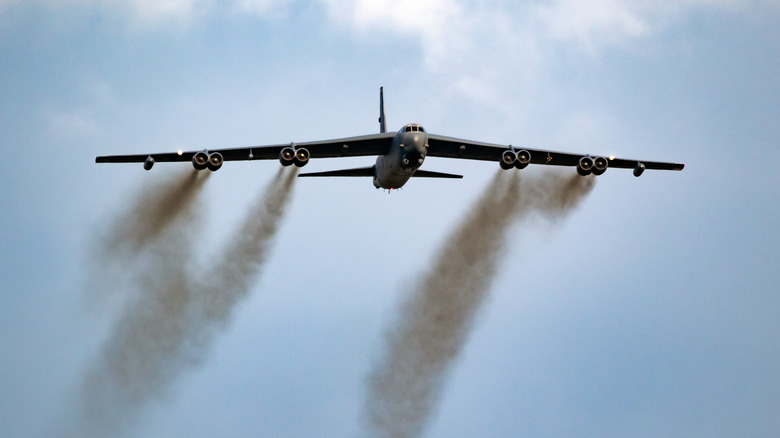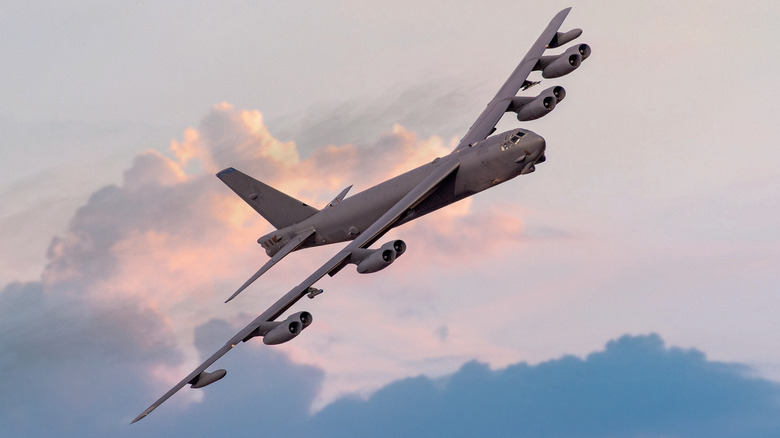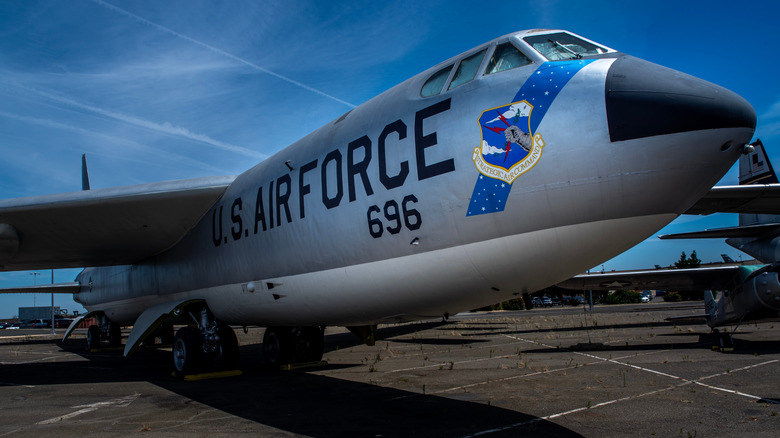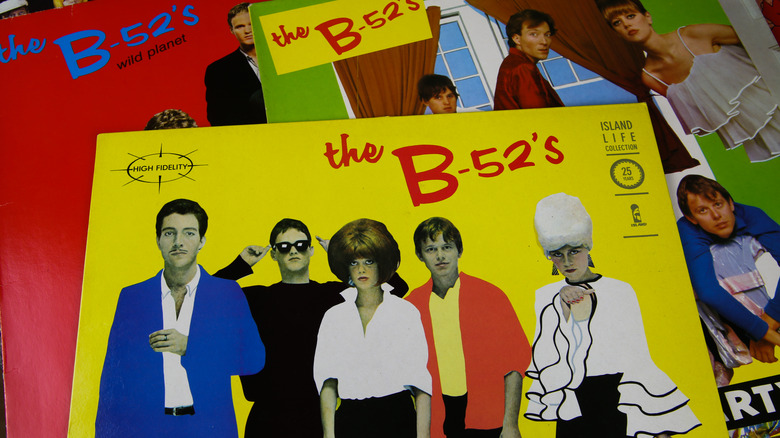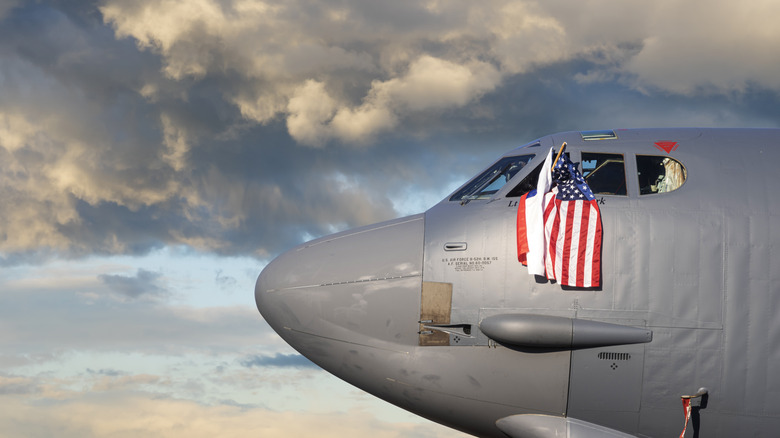The American Bomber That Infiltrated Pop Culture (And Is Still In Service)
Fame is a tricky thing. For some, mere chance results in immediate legendary status on the Internet. If you capture your dog doing something adorable, hilarious, or adorably hilarious at the right moment, that can be your ticket to a new career. That acclaim can also fizzle out just as quickly.
However, those who have truly burrowed their way into the collective consciousness of the world have never really needed the Internet to do so. Elvis Presley, Cher, the Beatles, Bert and Ernie, Wonder Woman, smartphones, iPods, and the ancient-but-still-relevant floppy disk — All these people and things are intimately familiar to many. The most acclaimed aircraft also have an eternal place in pop culture.
Though countless immediately recognizable aircraft models (such as the venerable Supermarine Spitfire) exist, few are as well-known as the U.S. B-52. This iconic bomber has been referenced in movies, TV shows, band names, and hairstyles.
The birth of the B-52 legend
The B-52H Stratofortress, as this aircraft is officially (and very intimidatingly) known, was a formidable aircraft that developed from a formidable brief. In November 1945, according to Marcelle Size Knaack's "Encyclopedia of U.S. Air Force Aircraft and Missile Systems, Volume II," the call was issued for a "bomber with an operating radius of 5,000 miles [...] a speed of 300 miles per hour (260 knots) [...] as well as a 10,000 pound bombload."
In 1955, the United States Air Force began to use the first B-52s (B-52Bs). One model, the B-52H, is still in active use with the Air Force Global Strike Command. This is a testament to the model's effectiveness, powerful arsenal, and capacity to keep up with the military's changing needs over the decades. Naturally, the model still in service today is far from identical to the one that took off in the 1950s. Still, remarkably, it has proven adaptable rather than fading into obscurity, as many other acclaimed aircraft have done over the years.
With devastatingly successful roles in Operation Desert Storm, Operation Enduring Freedom in 2001, and various other bombing campaigns over its decades-long history, the B-52 became, and remains, symbolic of the military might of the United States.
B-52: The Hairstyle
Aside from its long and distinguished career, its distinctive design is the main factor that catapulted the B-52 to iconic status. Its long, protruding nose brings to mind a Marge Simpson-esque beehive hairstyle, and this fact wasn't lost on anyone during one of the more outlandish hair styling eras.
CNN reports that towering, elaborate beehives were first popular in pre-revolutionary France. The well-to-do would wear small models, jewels, and other eye-catching items in their hair. Whether as a status symbol or to attract attention, it was quite the look by anyone's standards. Though this was several centuries before the introduction of the B-52 bomber (or any aircraft as we know them today), the bomber's name was used when the beehive came back into fashion during the swinging sixties.
During this bold, liberated time, many enjoyed the freedom for their hair to defy gravity as it pleased. The beehive was created in its modern guise by stylist Margaret Vinci Heldt in 1960. The rise of the formidable bomber, then, came along at the height of the beehive's popularity. The style earned its famous nicknames, beehive and B-52, for its resemblance to the structure and the aircraft's prominent nose, respectively.
Per TribLocal Elmhurst in 2010, Heldt proudly stated that the style was a "phenomenon ... worn by millions of women." Two such women, it seems, adored it so much that they named their iconic band after it.
The B-52's: The Band
The B-52's are among the biggest names in the history of new wave music. Their numerous beloved hits ("Love Shack" and "Rock Lobster" being just two infinitely catchy examples) propelled them to unforgettable status. Their identity is tied to their reputation, per their official biography, "The World's Greatest Party Band," and their name shared with the aircraft.
According to the outlet, the name is not derived from the plane but from the hairstyle: They "formed on an October night in 1976 following drinks at an Athens, GA, Chinese restaurant [...] Naming themselves after Southern slang for exaggerated 'bouffant' hairdos." The hairstyle itself may have emerged the decade before the band, but it, too, has proven to have remarkable longevity. Beehives are widely worn today, and the B-52's themselves have an upcoming residency at Venetian Resort Las Vegas' Venetian Theater from May to September 2023. B-52s of all kinds, then, are built to last.
The formidable nature of the aircraft has been emphasized in the world of movies, too. 1963's "A Gathering Of Eagles" stars Rock Hudson as Colonel Jim Caldwell, commander of a B-52 squadron during the Cold War. The unmistakable visage of the aircraft etched itself on the memories of many viewers. Here and elsewhere in cinema, it is highlighted how critical the iconic model has played since its introduction.
The future of the B-52
Aircraft, particularly military ones, often go through numerous redesigns and back-to-the-drawing-board moments before ever making it to production. Some never make it past the prototype stage, if they even reach it. However, the B-52's vast and rather unwieldy-looking frame lent itself to modifications, tweaks, and upgrades, and it has seen many over all its years in service.
According to the official website of the United States Air Force, the nuclear-armed B-52H model alone remains in service. It (and its Rolls-Royce engines) seem scheduled to do so for a considerable time. According to Forbes in 2020, the Air Force plans to continue to operate B-52s up to 2050.
This is the key to the B-52's unique position in pop culture. Much like the band of the same name, it has proven willing to adapt, try new things, and establish itself repeatedly. This is precisely how icons are made.
